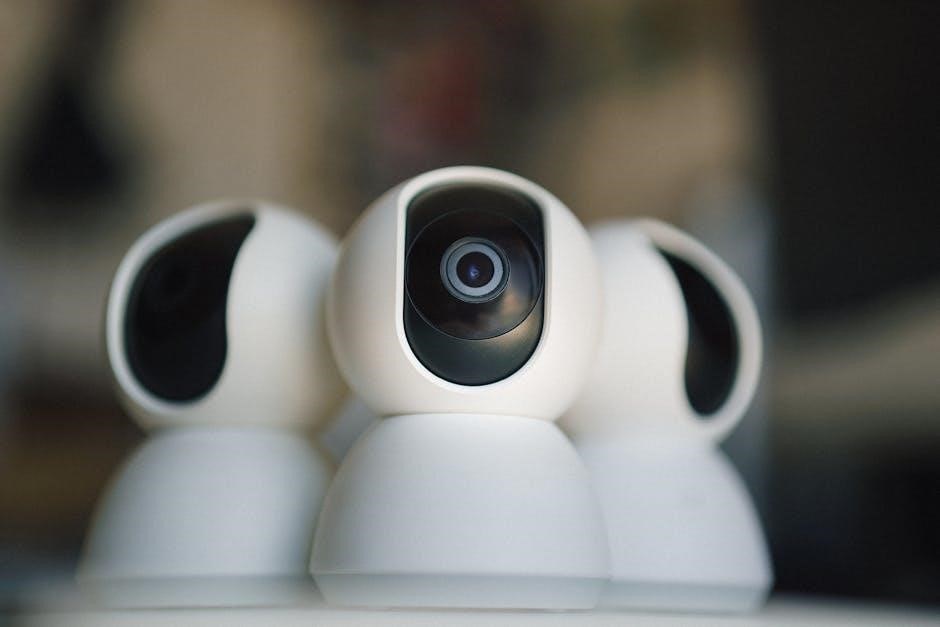The System Sensor D4120 is a advanced duct smoke detector designed for HVAC systems, ensuring fire safety in air ducts. It includes the D4P120 Power Board and D4S Sensor, providing reliable smoke detection in airflow speeds of 100 to 4,000 fpm. Genuine components maintain system integrity and compliance with safety standards. This manual guides installation, maintenance, and troubleshooting for optimal performance.
Overview of the System Sensor D4120
The System Sensor D4120 is a duct smoke detector designed to detect smoke in HVAC systems, ensuring fire safety in air ducts; It consists of two key components: the D4P120 Power Board and the D4S Sensor. The D4S Sensor is responsible for detecting smoke particles, while the D4P120 Power Board manages the power supply and communication. This system operates in airflow speeds of 100 to 4,000 feet per minute and temperatures between 4°F and 158°F, making it suitable for various environmental conditions. The D4120 is UL 268A listed, ensuring compliance with safety standards. Genuine System Sensor components are essential for optimal performance and reliability.

Importance of Using Genuine Components
Using genuine System Sensor components for the D4120 is crucial to ensure optimal performance and reliability. Genuine parts are specifically designed to meet the system’s specifications, guaranteeing proper functionality and compliance with safety standards. Counterfeit or non-genuine components can lead to system malfunctions, false alarms, and even complete failure, compromising fire safety. Additionally, genuine components are manufactured to withstand the operating conditions specified for the D4120, ensuring longevity and reliability. Using non-genuine parts may void the warranty and can result in non-compliance with regulatory requirements. Always prioritize genuine System Sensor components to maintain the integrity and effectiveness of your fire safety system. This ensures the D4120 operates as intended, providing reliable protection.

Key Components of the D4120
The D4120 comprises two essential components: the D4P120 Power Board, which manages electrical operations, and the D4S Sensor Component, responsible for detecting smoke in duct systems.
D4P120 Power Board Component
The D4P120 Power Board is a critical component of the D4120 duct smoke detector, responsible for managing the system’s electrical operations. It ensures stable power supply to the sensor and interfaces with the fire alarm control panel. The board is designed to operate within a temperature range of 40°F to 158°F (40°C to 70°C), making it suitable for various environmental conditions. Proper installation and wiring of the D4P120 are essential for reliable performance. It is recommended to use genuine System Sensor components to maintain system integrity and compliance with safety standards. Regular inspection and maintenance of the power board are necessary to ensure optimal functionality.
D4S Sensor Component
The D4S Sensor Component is a key part of the D4120 duct smoke detector, designed to detect smoke particles in HVAC ducts. It operates effectively in challenging conditions, including airflow speeds of 100 to 4,000 feet per minute and temperatures ranging from 4°F to 158°F (20°C to 70°C). The sensor uses advanced technology to provide accurate smoke detection, ensuring reliable fire safety in commercial and industrial applications. Regular cleaning and maintenance of the D4S are essential to prevent dust buildup and ensure optimal performance. The sensor integrates seamlessly with the D4P120 Power Board, enabling precise communication and alarm signaling. Using genuine System Sensor components ensures compliance with safety standards and system reliability.

Installation Instructions
Follow the step-by-step guide for installing the D4120 duct smoke detector, ensuring proper mounting, wiring, and configuration. Reference the manual for detailed instructions and UL compliance.
Pre-Installation Considerations
Before installing the D4120 duct smoke detector, ensure compliance with NFPA Standards 72, 90A, and 101. Verify the system’s compatibility with airflow speeds of 100 to 4,000 fpm and operating temperatures between 4°F and 158°F. Read the manual thoroughly to understand installation requirements and safety guidelines. Ensure all components, including the D4P120 Power Board and D4S Sensor, are genuine System Sensor parts to maintain reliability and meet safety standards. Reference the UL 268A listing for duct smoke detectors and ensure proper wiring and mounting locations. Always follow local fire safety regulations and consult the System Sensor Guide for Proper Use of Smoke Detectors in Duct Applications. Proper preparation ensures a safe and effective installation.
Mounting and Wiring the D4120

Mount the D4120 duct smoke detector in a horizontal or vertical position, ensuring it is securely fastened to the ductwork. Choose a location with consistent airflow, avoiding areas with turbulence or dead zones. Follow the manufacturer’s wiring diagram to connect the D4P120 Power Board and D4S Sensor, ensuring all connections are secure and meet local electrical codes. Use the appropriate 4-wire connection for power and communication. Verify that the detector is properly grounded to prevent electrical interference. After mounting, test the device to ensure proper function and communication with the fire alarm system. Always refer to the manual for specific wiring instructions and safety precautions to ensure a reliable installation. Proper mounting and wiring are critical for accurate smoke detection.
Configuration and Setup
Configure the D4120 duct smoke detector according to the manual to ensure proper operation. Follow the wiring diagram for the 4-wire connection, ensuring compatibility with the fire alarm control panel. Address the device correctly within the system to enable communication and monitoring. Set the sensitivity levels as per the application requirements, referencing NFPA standards for guidance. Use the test mode to verify smoke detection and alarm functionality. Ensure all settings comply with local fire safety regulations and UL standards. Proper configuration ensures reliable performance and accurate smoke detection in HVAC systems. Always use genuine System Sensor components to maintain system integrity and safety compliance.
Specifications
The D4120 operates at 4°F to 158°F (20°C to 70°C) and stores between -40°F to 158°F (-40°C to 70°C). It requires 12VDC or 24VDC power and functions in airflow speeds of 100 to 4,000 fpm.

Operating Temperature Range
The System Sensor D4120 operates effectively within a temperature range of 4°F to 158°F (20°C to 70°C). The D4S sensor component shares this range, while the D4P120 power board operates from 40°F to 158°F (40°C to 70°C). Proper installation ensures the detector functions reliably within these limits, avoiding extreme temperatures that could impair performance. Exceeding these ranges may result in reduced accuracy or potential damage to the unit. Always follow the manufacturer’s guidelines to maintain optimal performance and safety.
Storage Temperature Range
The System Sensor D4120 should be stored in an environment with a temperature range of -40°F to 158°F (-40°C to 70°C). This range ensures the integrity of the D4P120 Power Board and D4S Sensor components remains intact during storage. Storing the device outside of this range may lead to damage or compromised performance. It is important to keep the unit in a dry, clean environment to prevent moisture or contaminants from affecting its functionality. Always follow the manufacturer’s storage guidelines to ensure the detector operates correctly when installed. Proper storage conditions are essential for maintaining the reliability and accuracy of the D4120 duct smoke detector.
Airflow and Electrical Requirements
The System Sensor D4120 operates effectively in airflow speeds ranging from 100 to 4,000 feet per minute. It requires a stable power supply of 12 to 24 VDC to function correctly. The D4P120 Power Board must be connected to a compatible electrical system to ensure proper operation. Proper airflow and electrical connections are critical for accurate smoke detection and reliability. Failure to meet these requirements may result in reduced performance or false alarms. Always ensure the device is installed in accordance with the specified airflow and electrical guidelines to maintain its efficiency and safety standards. Refer to the manual for detailed wiring and installation instructions.
Maintenance and Care
Regular maintenance ensures optimal performance of the System Sensor D4120. Clean the detector to prevent dust buildup and inspect electrical connections for integrity. Schedule periodic checks to ensure all components function properly.
Cleaning the Smoke Detector
Regular cleaning of the System Sensor D4120 is essential to ensure optimal performance and reliability. Dust and debris can accumulate on the sensor, potentially causing false alarms or reduced sensitivity. To clean the detector, turn off the power supply and gently vacuum the smoke detector screen using a soft-bristle brush attachment. Avoid touching or damaging the sensor components. For stubborn dirt, dampen a soft cloth with distilled water and wipe the exterior carefully. Never use harsh chemicals or abrasive materials, as they may damage the unit. After cleaning, inspect the detector for any signs of wear or damage and replace parts if necessary. Always refer to the manual for specific cleaning instructions to maintain warranty and functionality.
Replacing Wear Parts
Regular replacement of wear parts in the System Sensor D4120 ensures optimal performance and longevity. Check for wear indicators on components like the sensor kit and seal kit. Replace parts showing signs of deterioration. Use genuine System Sensor replacement kits, such as the SEAL KIT-DISC BRAKE or SENSOR KIT-WEAR INDICATOR, to maintain reliability. Before replacing, power down the device and follow the manual’s instructions for safe disassembly. Dispose of worn parts responsibly. Always test the detector after replacement to ensure proper functionality. Genuine components guarantee compliance with safety standards and prevent potential malfunctions. Refer to the manual for a detailed list of replaceable parts and procedures.
Regular Testing and Inspection
Regular testing and inspection of the System Sensor D4120 are crucial for ensuring its reliability and performance. Perform functional tests monthly, including activating the test button to verify proper operation. Check for any signs of wear or damage to components, such as corrosion or debris buildup. Ensure the detector is clean and free from contaminants that could impair its function. Refer to NFPA Standards 72 and 90A for detailed testing requirements. Always use genuine System Sensor replacement parts if repairs are needed. Maintain a record of all inspections and tests for compliance and future reference. Regular maintenance ensures the detector operates effectively in various airflow conditions and temperature ranges.

Troubleshooting Common Issues
This section addresses frequent challenges with the D4120, such as power issues, false alarms, and communication problems. Solutions are provided to restore functionality and ensure optimal performance.
Power Issues and Solutions
The D4120 may experience power-related issues due to loss of voltage, faulty wiring, or component malfunctions. Ensure the power supply meets the required specifications. Check connections for tightness and verify circuit integrity. If the unit does not power on, inspect the D4P120 Power Board for damage or wear. Replace faulty components with genuine System Sensor parts to maintain reliability; Additionally, ensure the operating temperature remains within the specified range (40°F to 158°F) to prevent power-related malfunctions. Regularly test the system to identify and resolve issues promptly. Always refer to the manual for detailed troubleshooting steps and safety guidelines.
Addressing False Alarms
False alarms in the D4120 can occur due to dust, dirt, or improper installation. Regularly clean the D4S sensor component with a soft brush or vacuum to remove contaminants. Ensure proper airflow and check for obstructions in the ductwork. Verify that the detector is installed correctly, following NFPA guidelines and the manual’s instructions. If false alarms persist, inspect the wiring for damage or loose connections. Adjust the sensor’s sensitivity if necessary, but refer to the manual for specific settings. Testing the system periodically can help identify and resolve issues promptly. Always ensure the environment meets the operating specifications to minimize false alarms. Consult the manual for detailed troubleshooting procedures.
Communication Problems
Communication issues with the D4120 may arise due to wiring problems or component mismatches. Ensure all connections are secure and free from damage. Verify that the D4P120 Power Board and D4S Sensor are properly linked. Electrical interference or incorrect wiring can disrupt communication. Check for loose connections and ensure the system is grounded correctly. If issues persist, reset the detector and power board. Refer to the manual for specific troubleshooting steps, such as checking communication protocols or addressing firmware compatibility. Always ensure components are genuine and meet System Sensor specifications to maintain reliable communication. Consulting the manual or contacting technical support can resolve complex communication problems effectively.
The System Sensor D4120 duct smoke detector is a reliable solution for fire safety in HVAC systems, offering precise smoke detection in challenging conditions. Its components, including the D4P120 Power Board and D4S Sensor, ensure optimal performance. With an operating temperature range of 4°F to 158°F and airflow compatibility from 100 to 4,000 fpm, the D4120 meets UL 268A standards. Regular maintenance, such as cleaning and replacing wear parts, is essential for longevity. Users should always refer to the manual for installation, configuration, and troubleshooting guidelines. By following the provided instructions and using genuine System Sensor components, the D4120 delivers consistent fire safety in commercial and industrial settings. Proper care ensures reliable operation and compliance with safety regulations.